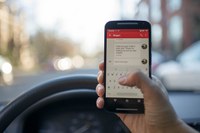Prairie Fare: Driving With Distractions Can Be a Recipe for Disaster
(Click an image below to view a high-resolution image that can be downloaded)
By Julie Garden-Robinson, Food and Nutrition Specialist
NDSU Extension
I noticed a vehicle in front of me crossing the center line, then swerving toward the shoulder of the road.
The vehicle moved back into position when it crossed the “rumble strip.” The vehicle sped up, then slowed down to far below the speed limit.
I looked around for a patrol car because this driver seemed to be impaired. Maybe the driver was falling asleep. I decided I wanted to get around this vehicle as soon as it was moving in a consistent straight line.
As I pulled around the vehicle, I could see the telltale glow of a cellphone screen. The driver glanced at me as he took a bite out of a big sandwich. This guy was awake but was distracted by his multitasking.
Did he know that texting while driving is illegal in most states and carries a significant fine? He also was endangering himself and other drivers around him.
Distracted driving was linked to 3,450 deaths in 2016 in the U.S. In 2015, 391,000 injuries were linked to distracted drivers.
I have spent quite a bit of time driving to meetings and workshops in my career. Through the years, I have seen people reading articles on hand-held devices, applying makeup and doing their hair, and people disappearing from view as they reach down for items that fell on the floor.
I’ve also observed people eating plates of food with a fork while driving.
As you can see, I sometimes find the behavior of other drivers distracting. I definitely am not a risk-taker when I’m in the driver’s seat.
I still hear the wise words of my dad: “Remember, you have to drive for the other guy.” Perhaps a parent or grandparent said that to you, too.
Researchers have classified driving distractions into three main areas: cognitive, visual and manual.
Cognitive distraction refers to using your brain for something other than focusing on the task of driving. Most of us “talk and drive” when we have passengers in the vehicle, but that practice is less dangerous than holding a phone and talking into it.
Being tired can affect your ability to make quick decisions. In fact, researchers reported that 4 percent of 150,000 surveyed drivers had fallen asleep in the previous 30 days.
Being visually distracted means you are taking your eyes off the road. Maybe the radio station suddenly became full of static and you are looking at and twisting the dial or punching buttons, trying to find another station. Maybe you are trying to retrieve a piece of candy that fell out of a package onto the floor. Perhaps you decide to change the destination on your GPS.
If you need to use a GPS, then set your destinations before you go on your trip. Or engage a “co-pilot” (passenger) to be the navigator.
Finally, we have manual distractions, which are things done with your hands. Do you take one or both hands off the steering wheel to look for something in your backpack or a bag? Drinking soda or coffee and eating food would be considered manual distractions.
Texting while driving is distracting on all three levels: visually, manually and cognitively.
The U.S. Department of Transportation has these suggestions for avoiding distractions:
- Turn off electronic devices and put them out of reach before starting to drive.
- Be good role models for young drivers and set a good example. Talk with teens about responsible driving.
- Speak up when you are a passenger and your driver uses an electronic device while driving. Offer to make the call for the driver so the person’s full attention stays on the driving task.
- Always wear your seat belt. Seat belts are the best defense against unsafe drivers.
- See your state laws related to these factors. In North Dakota, see https://www.dmv.com/nd/north-dakota/distracted-driving-laws.
If you are looking for a healthful beverage, here’s a grab-and-go smoothie. Adding a drinking straw will help you keep your eyes on the road if you decide to take an occasional sip.
Green Smoothie
1 1/2 c. strawberries, hulled
2 c. spinach
1/2 banana, peeled
1 Tbsp. orange juice concentrate
1/2 single serving low-fat yogurt, any flavor
1/4 to 1/2 cup milk, water or juice
Place prepared ingredients in freezer-safe bag. Push out air and lay flat in freezer. When ready to prepare, place ingredients in blender with 1/4 to 1/2 cup milk, water or juice.
Makes two servings. Each serving has 160 calories, 2 grams (g) fat, 6 g protein, 32 g carbohydrate, 4 g fiber and 95 milligrams sodium.
(Julie Garden-Robinson, Ph.D., R.D., L.R.D., is a North Dakota State University Extension food and nutrition specialist and professor in the Department of Health, Nutrition and Exercise Sciences. Follow her on Twitter @jgardenrobinson)
NDSU Agriculture Communication - Sept. 27, 2018
| Source: | Julie Garden-Robinson, 701-231-7187, julie.garden-robinson@ndsu.edu |
|---|---|
| Editor: | Ellen Crawford, 701-231-5391, ellen.crawford@ndsu.edu |



